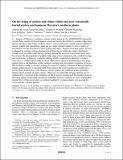| dc.contributor.author | Freed, Andrew M. | |
| dc.contributor.author | Blair, David M. | |
| dc.contributor.author | Watters, Thomas R. | |
| dc.contributor.author | Klimczak, Christian | |
| dc.contributor.author | Byrne, Paul K. | |
| dc.contributor.author | Solomon, Sean C. | |
| dc.contributor.author | Zuber, Maria | |
| dc.contributor.author | Melosh, H. Jay | |
| dc.date.accessioned | 2014-03-27T19:30:12Z | |
| dc.date.available | 2014-03-27T19:30:12Z | |
| dc.date.issued | 2012-12 | |
| dc.date.submitted | 2012-09 | |
| dc.identifier.issn | 01480227 | |
| dc.identifier.uri | http://hdl.handle.net/1721.1/85933 | |
| dc.description.abstract | Images of Mercury's northern volcanic plains taken by the MESSENGER spacecraft reveal a large number of buried impact craters and basins discernible by wrinkle-ridge rings that overlie their rims. Many of these “ghost” craters and basins contain interior graben of diverse widths and orientations. Here we use finite element models to test a variety of mechanisms for the formation of these graben and ridges. Results show that graben are best explained by cooling of large thicknesses of flood lavas within the craters and basins; conservation of surface area during cooling induces the required extensional stress state. In contrast, the development of wrinkle-ridge rings is best explained as the result of cooling and contraction of Mercury's interior, during which a reduction in Mercury's surface area led to a compressional state of stress. The critical factor in determining where large graben form is the thickness of the youngest cooling unit, the topmost sequence of lavas that cooled coevally. A thicker cooling unit leads to a deeper initiation of normal faulting (wider graben floors). Consistent with observations, the widest graben are predicted to occur where pooled lavas were thickest, and no graben are predicted within generally thinner plains outside of major craters. Observed concentrically oriented graben can be explained by variations in the thickness of the youngest cooling unit. In contrast, none of the basin uplift mechanisms considered, including isostatic response to crater topography, inward flow of the lower crust, or exterior loading by volcanic plains, can account for concentrically oriented graben. | en_US |
| dc.description.sponsorship | United States. National Aeronautics and Space Administration (MESSENGER, NASA Discovery Program, contract NASW-00002) | en_US |
| dc.description.sponsorship | United States. National Aeronautics and Space Administration (NASA grant PGG09-0053) | en_US |
| dc.description.sponsorship | United States. National Aeronautics and Space Administration (NASA grant NAS5-97271) | en_US |
| dc.language.iso | en_US | |
| dc.publisher | American Geophysical Union | en_US |
| dc.relation.isversionof | http://dx.doi.org/10.1029/2012je004119 | en_US |
| dc.rights | Article is made available in accordance with the publisher's policy and may be subject to US copyright law. Please refer to the publisher's site for terms of use. | en_US |
| dc.source | MIT web domain | en_US |
| dc.title | On the origin of graben and ridges within and near volcanically buried craters and basins in Mercury's northern plains | en_US |
| dc.type | Article | en_US |
| dc.identifier.citation | Freed, Andrew M., David M. Blair, Thomas R. Watters, Christian Klimczak, Paul K. Byrne, Sean C. Solomon, Maria T. Zuber, and H. J. Melosh. “On the Origin of Graben and Ridges Within and Near Volcanically Buried Craters and Basins in Mercury’s Northern Plains.” J. Geophys. Res. 117, no. E12 (December 2012): n/a–n/a. | en_US |
| dc.contributor.department | Massachusetts Institute of Technology. Department of Earth, Atmospheric, and Planetary Sciences | en_US |
| dc.contributor.mitauthor | Zuber, Maria | en_US |
| dc.relation.journal | Journal of Geophysical Research: Planets | en_US |
| dc.eprint.version | Final published version | en_US |
| dc.type.uri | http://purl.org/eprint/type/JournalArticle | en_US |
| eprint.status | http://purl.org/eprint/status/PeerReviewed | en_US |
| dspace.orderedauthors | Freed, Andrew M.; Blair, David M.; Watters, Thomas R.; Klimczak, Christian; Byrne, Paul K.; Solomon, Sean C.; Zuber, Maria T.; Melosh, H. J. | en_US |
| dc.identifier.orcid | https://orcid.org/0000-0003-2652-8017 | |
| mit.license | PUBLISHER_POLICY | en_US |
| mit.metadata.status | Complete | |
